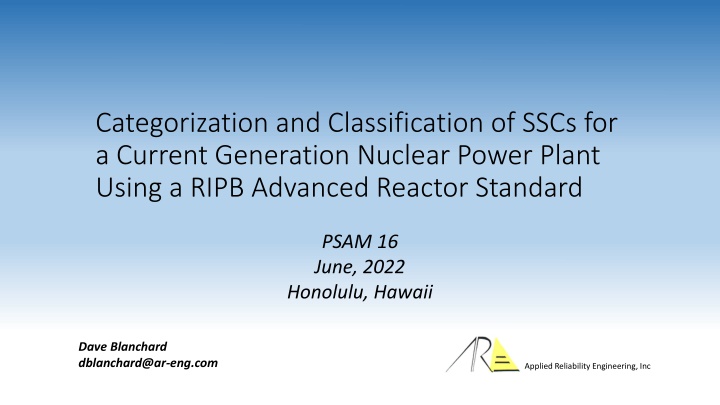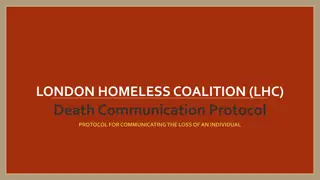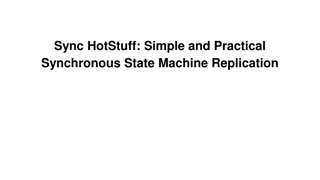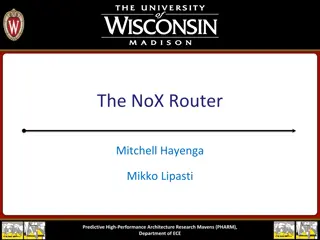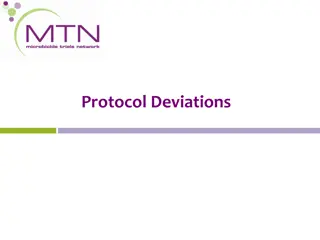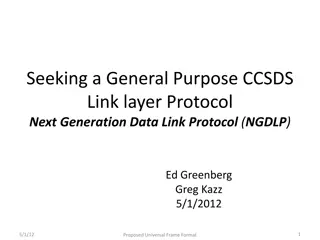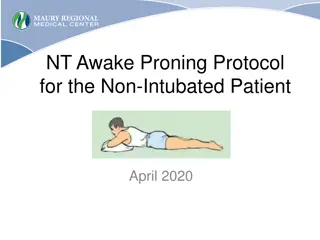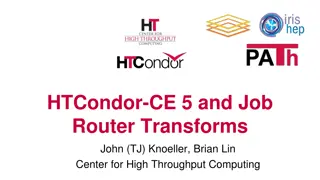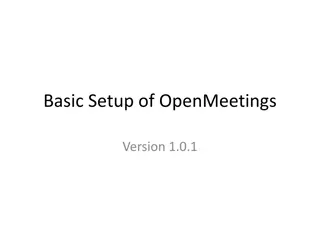Basic Router Configuration for Communication Protocol Setup
Configuring two routers, Router A and Router B, for communication using different network interfaces and protocols. Setting up IP addresses, enabling interfaces, configuring routing protocols (RIP and OSPF), and testing connectivity between the routers. The setup includes detailed commands and steps for a successful configuration.
Download Presentation

Please find below an Image/Link to download the presentation.
The content on the website is provided AS IS for your information and personal use only. It may not be sold, licensed, or shared on other websites without obtaining consent from the author.If you encounter any issues during the download, it is possible that the publisher has removed the file from their server.
You are allowed to download the files provided on this website for personal or commercial use, subject to the condition that they are used lawfully. All files are the property of their respective owners.
The content on the website is provided AS IS for your information and personal use only. It may not be sold, licensed, or shared on other websites without obtaining consent from the author.
E N D
Presentation Transcript
Categorization and Classification of SSCs for a Current Generation Nuclear Power Plant Using a RIPB Advanced Reactor Standard PSAM 16 June, 2022 Honolulu, Hawaii Dave Blanchard dblanchard@ar-eng.com Applied Reliability Engineering, Inc
Categorization and Classification of SSCs for a Current Generation Nuclear Power Plant Using a RIPB Advanced Reactor Standard Motivation for this evaluation ANS/ANSI 30.3* is a recently completed RIPB advanced light water reactor design standard that has received public review and comment, was recently balloted and approved and is expected to be published in 2022. During its development, its guidance was tested as one means of ensuring its ability to be implemented. A current generation plant PRA was used as a part of this testing to address what might have been classified as Safety Related had insights from the PRA been available at the time that it was licensed. *ANS/ANSI 30.3-202x, Light Water Reactor Risk-Informed Performance-Based Design
Categorization and Classification of SSCs for a Current Generation Nuclear Power Plant Using a RIPB Advanced Reactor Standard Outline ANS/ANSI 30.3-202x Light Water Reactor Risk-Informed Performance-Based Design Top Level Criteria & Definition of Plant Capability Defense in Depth and Risk Significance Description of PWR reviewed against ANS/ANSI 30.3 Classification results (deterministic) Categorization results (probabilistic) Summary
ANSI/ANS 30.3 Table of Contents 1. 2. 3. 4. 5. 6. 7. 8. 9. 10. Systematic Defense-in-Depth 11. Performance Based Decisionmaking 12. References Purpose and scope Acronyms and Definitions Nuclear Reactor Design Process Safety Requirements and Functions Licensing Basis Event Identification Design Basis Safety Analysis Probabilistic Risk Assessment Severe Accident Considerations Classification and Categorization of Systems, Structures and Components
ANS/ANSI 30.3 Licensing Basis Event Identification ANS/ANSI 30.3 provides flexibility in the development of licensing basis events Acceptable approaches encompass the following spectrum: Traditional deterministic approach supplemented by information from the PRA Blend of deterministic/probabilistic methods in between Beginning with the accident sequences of the PRA, identifying those most important to risk and adjusting them to reflect deterministic defense-in- depth considerations
ANS/ANSI 30.3 Classification Hi Risk Classification is deterministic in ANS/ANSI 30.3 Objective is to place SSCs into three classes Safety related Non safety related (with special treatment requirements) Non safety (no special treatment requirements) Endorses classification guidance of ANS/ANSI 58.14-2011 Safety and pressure integrity classification criteria for light water reactors Lo Risk NSR SR Note: ANS/ANSI 58.14 is a deterministic standard that was not developed to be RIPB (However, see footnote on bottom of next slide)
ANS/ANSI 30.3 SSC classification guidance of ANS/ANSI 58.14-2011 Relied upon* for DBEs: the SSCs that are necessary and sufficient (i.e., the minimal subset of SSCs) to assure each of the three basic safety-related functions in the presence of a postulated single failure plus any other coincident occurrence assumed in the safety analysis; for special events: the SSCs that are nec- essary and sufficient (i.e., the minimal sub- set of SSCs) to assure required functions in the presence of postulated failures (e.g., common cause) related to the specific special event. Safety Related Applies to a function, SSC, or part that is relied upon during or following a DBE to ensure any of the three functions Primary system integrity Shutdown the reactor and maintain safe shutdown Limit releases *The definition of relied upon allows the use of fault tree analysis methods to identify SSCs that are candidates for classification as SR.
ANS/ANSI 30.3 - Categorization Hi Risk Lo Risk Categorization brings in risk metrics and applies performance based criteria No specific thresholds are endorsed for high and low risk significance The designer is allowed flexibility in defining what is meant by risk significant A final sensitivity study is used as a basis to demonstrate the effectiveness of the selected SSCs in managing risk The selected SSCs consist of those identified as SR and NSRST during classification and risk significant as a part of categorization NSR SR
ANS/ANSI 30.3 - Categorization Characteristics of the risk significance sensitivity study The analysis shall use conservative failure assumptions for SSCs categorized as not safety significant. Such conservative assumptions may range across the following spectrum: No preventive or mitigative credit is taken for SSCs that are not risk significant (e.g., these SSCs are assumed failed). Failure probabilities are assigned to SSCs that are not risk significant for which their performance shall be monitored in a reliability assurance program and corrective actions taken if the performance criteria are not met. An engineering rationale for the risk significance categorization of each SSC shall be developed and documented. The designer is allowed to raise or lower initial classification and categorization results based on the outcome of the final sensitivity analysis accompanied by development of an engineering rationale justifying the change.
Top Level Criteria & Definition of Plant Capability Defense in Depth and Risk Significance Select a high level measure that reflects effective protection of public health & safety (e.g.,): One or more of the three basic safety functions Primary system integrity Shutdown reactor and maintain safe shutdown Limit releases Frequency-consequence curve Plant Capability Defense in Depth Identify SSCs necessary to meet deterministic criteria of ANS/ANSI 58.14 Add SSCs useful in meeting (and providing margin on) risk significance criteria Risk significance Identify SSCs necessary to meet risk criteria for selected metric(s) Add SSCs useful in meeting (and providing margin on) risk significance criteria ANS/ANSI 30.3 gives the designer the flexibility of identifying the specific metrics to be used to define safety }
Current Generation PWR Characteristics Began operation early 1970s ATWS Residual Transient, w/o 2nd cooling, no F&B 3 train AFW 2 train HPSI/LPSI 2 division Emergency AC Internal fire, flood and external event related SSCs are credited in the internal events PRA SGTR LOCA, inj failure Application of ANS/ANSI 30.3: Use Core Damage Frequency for internal events PRA as surrogate for Shutdown reactor and maintain safe shutdown safety function LOCA, recirc failure Quantitative safety goal as criterion for this safety function (1E-4/yr) Baseline CDF = 6E-6/yr
Classification Implement ANS/ANSI 58.14 deterministic criteria using the PRA logic models Relied upon SSCs that are necessary and sufficient (i.e., the minimal subset of SSCs) to assure each of the three basic safety-related functions in the presence of a postulated single failure SSCs that are candidates for classification as Safety Related can be identified directly from the fault trees and cut sets of the PRA. In this presentation, the definition of relied upon was implemented using the PRA by applying a method known as Top Event Prevention Analysis.
Top Event Prevention Analysis Concepts and Definitions Prevention Analysis Fault Tree Analysis Top Event Top Event Top of fault tree or any Boolean expression Top of fault tree or any Boolean expression Prevention Sets Cut Sets Combination of events that will prevent the occurrence of the Top Event Combination of events that will result in the failure represented by the Top Event Prevention Level Truncation Level Desired number of events in each cut set that, if prevented, will preclude the occurrence of the Top Event Desired probability or order which makes each cutset insignificant Credited Events Basic events that are to be credited toward the prevention of the Top Event Excluded Events Basic events that are not credited toward the prevention of the Top Event
Top Event Prevention Analysis: Simple Example Top Event SW N2 N -4 10 C1 A -3 10 C2 A Air Dryer C3 C2 C1 C3 -2 10 Compressors Air Receivers 10 10 10 10 -2 -2 C2 SW C3 SW -4 -4 10 N * A 10 10 N * C1 * C2 * C3 -7 N 1.0 104 A C1 10-3 1.2 C2 10-3 1.1 C3 10-3 1.1 SW 10-3 10 Fussell-Vesely Risk Achievement Worth N * C1 * SW -10 Importance measures ~1.0 103 -10 Prevention Sets Level 2 Minimal Level 2 Prevention Sets Top Event N * A * C1 + N * A * C2 * SW + N * A * C3 * SW. N * A + N * C1 * SW + N * C1 * C2 * C3. (N*A) * (N*C1 + N*SW + C1*SW ) * (N*C1 + N*C2 + N*C3 + C1*C2 + C1*C3 + C2*C3). Prevention analysis 14
Classification (1st iteration) Application of ANS/ANSI 58.14 deterministic criteria Build and solve model for core damage >600,000 cut sets (modularization, truncation 1E-14/yr) Define Prevention Level (deterministic) Level 2 prevention (to meet the definition for relied upon in ANS/ANSI 58.14) For each cut set, generate expression that represents prevention by selected criteria Credited events Excluded events Examples Initiating Events SSCs with marginal reliability (e.g., RVs challenged to relieve water) Selected Operator actions short time frames/high stress moderate to high conditional actions Form Boolean product Expand Simplify (>1E9 prevention sets) (up to 770 basic events in length) 15
Classification (1st iteration) Application of ANS/ANSI 58.14 deterministic criteria Example Results Example candidates for classification as non Safety Related BOP SSCs AC power/DC power Switchyard components Selected 2400v, 480v buses One division of DC Main steam line isolation Feed & Bleed support PORVs Incl op action to initiate F&B Special events Blackout EDG App R, NFPA-805 equipment (e.g., hot shutdown panel) FLEX equipment Example candidates for classification as Safety Related AFW 3 trains needed to meet single failure criterion HPSI/LPSI 2 trains incl op actions to align recirc AC power/DC power Both emergency diesels Offsite power One division of DC Instrument air SGTR needs isolation of affected SG which requires instrument air
Categorization (1st iteration) Testing the effectiveness of deterministically selected SSCs on risk Set all events that are not selected using the deterministic criteria to True. CDF rises multiple orders of magnitude 99% if the increase comes from the highest frequency initiating events Manual shutdown Turbine trip Very small LOCA Loss of feedwater Loss of main condenser Loss of offsite power Revise the deterministic criteria to require three failures for the above high frequency events (Level 3 prevention)
Classification (2nd iteration) Application of ANS/ANSI 58.14 deterministic criteria Build and solve model for core damage >600,000 cut sets (modularization, truncation 1E-14/yr) same as 1st iteration Define Prevention Level (deterministic) Level 3 prevention for high frequency initiating events (exceeds 58.14 criterion) Level 2 prevention (to meet the definition for relied upon in ANS/ANSI 58.14) For each cut set, generate expression that represents prevention by selected criteria Credited events Excluded events same as 1st iteration Form Boolean product Expand Simplify (~7E6 prevention sets) (up to 870 basic events in length) 18
Categorization (2nd iteration) Testing the effectiveness of deterministically selected SSCs on risk Set all events that are not selected using the revised deterministic criteria to True. CDF is slightly greater than risk criterion (1E-4/yr) Identify SSCs dominating the residual risk increase using importance measure (e.g., Fussell-Vesely) ~2 dozen basic event (or modules) identified that return the CDF to within the risk criterion with margin A number of operator recovery actions (e.g., alignment of blackout diesel) Charging components affecting makeup and pressurizer level control Additional instrument air trains
Selected examples of application of blending deterministic and risk criteria to the PRA Example candidates for classification as non Safety Related Example candidates for classification as Safety Related or non Safety Related with special treatment requirements AFW Instrument air SGTR needs isolation of affected SG Backup to SR pneumatic supplies for ECCS valves Feed & Bleed support PORVs Incl op action initiate F&B BOP SSCs Main steam line isolation Special events App R, NFPA-805 equipment (e.g., hot shutdown panel) FLEX equipment 3 trains needed HPSI/LPSI 2 trains incl op actions to align recirc AC power/DC power Both emergency diesels Swyd comp supporting emergency buses Blackout diesel Both DC divisions
ANS/ANSI 30.3 Sensitivity Study Results Residual Trans, no 2nd cooling, no F&B rec ATWS LOCA, inj failure ATWSResidual Transient, w/o 2nd cooling, no F&B Trans, no 2nd cooling, no F&B inj SGTR LOCA, inj failure LOCA, rec failure LOCA, recirc failure SGTR Baseline CDF crediting all SSCs modeled in the PRA - 6E-6/yr CDF crediting only SSC candidates for classification as SR or NSRST - 3E-5/yr
ANS/ANSI 30.3 Sensitivity Study Results Why is a factor of 5 increase acceptable when crediting only SSCs that are SR or NSRST? Margin remains on the risk criteria in which other events (e.g., earthquakes, internal fires and floods) can be accommodated. Risk informed guidance, such as NEI 00-04, suggests that common cause events having a Risk Achievement Worth less than 20 need not be considered risk significant. In this evaluation, multiple entire systems collectively are assumed not to perform their functions resulting in a factor of three less than the CCF risk significance guidance of NEI 00-04.
Summary ANS/ANSI 30.3 provides practical and flexible guidance in the classification and categorization of SSCs that is performance based. The logic models of the PRA can be used Deterministically to identify a subset of SSCs that meet the deterministic defense in depth criterion of ANS/ANSI 58.14, e.g., Identify a minimal set of SSCs that should be candidates for classification as Safety Related Probabilistically to identify those SSCs collectively effective in managing safety, e.g., Provide margin on meeting established risk criteria Identify additional SSCs that may be candidates for classification as non Safety Related but require attention with special treatment or in a reliability assurance program
Categorization and Classification of SSCs for a Current Generation Nuclear Power Plant Using a RIPB Advanced Reactor Standard Next steps
Risk-Informed Performance-Based (from SRM to SECY 98-144) A risk-informed approach enhances the deterministic approach by: allowing explicit consideration of a broader set of potential challenges to safety, providing a logical means for prioritizing these challenges based on risk significance, operating experience, and/or engineering judgment, facilitating consideration of a broader set of resources to defend against these challenges, explicitly identifying and quantifying sources of uncertainty in the analysis (although such analyses do not necessarily reflect all important sources of uncertainty), and leading to better decision-making by providing a means to test the sensitivity of the results to key assumptions.
Risk-Informed Performance-Based (from SRM to SECY 98-144) A performance based approach relies upon: measurable (or calculable) outcomes (i.e., performance results) to be met, but provides more flexibility to the licensee as to the means of meeting those outcomes. establishes performance and results as the primary basis for regulatory decision- making, and incorporates the following attributes: measurable (or calculable) parameters (i.e., direct measurement of the physical parameter of interest or of related parameters that can be used to calculate the parameter of interest) exist to monitor system, including facility and licensee , performance, objective criteria to assess performance are established based on risk insights, deterministic analyses and/or performance history, licensees have flexibility to determine how to meet the established performance criteria in ways that will encourage and reward improved outcomes; and a framework exists in which the failure to meet a performance criterion, while undesirable, will not in and of itself constitute or result in an immediate safety concern.
RIPB Categorization and Classification References Standards ANS/ANSI 30.3 Light Water Reactor Risk-Informed Performance-Based Design ANS/ANSI 58.14 Safety and pressure integrity classification criteria for light water reactors ANS/ANSI 53.1 nuclear safety design process for modular helium-cooled reactor plants ANS/ANSI 54.1 Nuclear Safety Criteria and Design Process for Sodium Fast Reactor Nuclear Power Plants Methods NEI 18-04 Risk-Informed Performance-Based Technology Inclusive Guidance for Non-Light Water Reactor Licensing Basis Development NEI 00-04 10 CFR 50.69 SSC Categorization Guideline
RIPB Categorization and Classification References Top Event Prevention Analysis Top Event Prevention in Complex Systems , Proceedings of the 1995 Joint ASME/JSME Pressure Vessels and Piping Conference, June 1995 Top Event Prevention Analysis, A Deterministic Use of PRA , Proceedings of the International KNS/ANS Topical Meeting on PSA, 1995. Risk-Informed Physical Security; Dynamic Allocation of Resources , Proceedings of PSA '05, Sep 2005 EPRI 1019183 Effects of Digital I&C Defense-in-Depth and Diversity on Risk in Nuclear Power Plants , December 2009. Risk Informed Safety Margin Characterization Case Study: Selection of Electrical Equipment To Be Subjected to Environmental Qualification , INL/EXT-11-23479 Rev. 1, April 2012 HAZCADS Hazard Analysis and Consequence Analysis of Digital Systems , EPRI 3002012755, December 2018
